Home | Category: Abbasids / Muslim Culture and Science / Abbasids / Arab Culture
FAMOUS MUSLIM SCIENTISTS AND SCHOLARS

Jabir ibn Hayyan, chemist
Science: Jabir Ibn Haiyan (Geber); Chemistry (Father of Chemistry); Died 803 C.E.
Al-Asmai; Zoology, Botany, Animal Husbandry; 740 - 828
Ibn Ishaq Al-Kindi (Alkindus); Philosophy, Physics, Optics, Medicine, Mathematics, Metallurgy; 800 - 873
Thabit Ibn Qurrah (Thebit); Astronomy, Mechanics, Geometry, Anatomy; 836 - 901
'Abbas Ibn Firnas; Mechanics of Flight, Planetarium, Artificial Crystals; Died 888
Al-Farghani (Al-Fraganus); Astronomy, Civil Engineering; C. 860
Al-Sufi (Azophi); Astronomy; 903 - 986
Ibn Al-Haitham (Alhazen); Physics, Optics, Mathematics; 965 - 1040
Abu Raihan Al-Biruni; Astronomy, Mathematics. (Determined Earth's Circumference); 973-1048
Al-Zarqali (Arzachel); Astronomy (Invented Astrolabe); 1028 - 1087, [Source: Dr. A. Zahoor]
Mathematics: Al-Khwarizmi (Algorizm); Mathematics, Astronomy, Geography. (Algorithm, Algebra, calculus); 770 - 840
Al-Battani (Albategnius); Astronomy, mathematics, Trigonometry; 858 - 929
Muhammad Al-Buzjani; Mathematics, Astronomy, Geometry, Trigonometry; 940 - 997
Omar Al-Khayyam; Mathematics, Poetry; 1044 - 1123
Medicine: Ali Ibn Rabban Al-Tabari; Medicine, Mathematics, Calligraphy, Literature; 838 - 870
Al-Razi (Rhazes); Medicine, Ophthalmology, Smallpox, Chemistry, Astronomy; 864 - 930
Abu Al-Qasim Al-Zahravi (Albucasis); Surgery, Medicine. (Father of Modern Surgery); 936 - 1013
Ibn Sina (Avicenna); Medicine, Philosophy, Mathematics, Astronomy; 981 - 1037
Philosophy and Humanities:
'Amr ibn Bahr Al-Jahiz; Zoology, Arabic Grammar, Rhetoric, Lexicography; 776 - 868
Al-Farabi (Al-Pharabius); Sociology, Logic, Philosophy, Political Science, Music; 870 - 950
Abul Hasan Ali Al-Masu'di; Geography, History; Died 957
Al-Mawardi (Alboacen); Political Science, Sociology, Jurisprudence, Ethics; 972 - 1058
Al-Ghazali (Algazel); Sociology, Theology, Philosophy; 1058 - 1111
Early Scientists: After the beginning of The Crusades and the fall of Muslim Toledo (1085), Corsica and Malta (1090), Provence (1050), Sicily (1091) and Jerusalem (1099).
Abu Bakr Muhammad Ibn Yahya (Ibn Bajjah); Philosophy, Medicine, Mathematics, Astronomy, Poetry, Music; 1106 - 1138
Ibn Zuhr (Avenzoar); Surgery, Medicine; 1091 - 1161
Al-Idrisi (Dreses); Geography (World Map, First Globe); 1099 - 1166
Ibn Tufayl, Abdubacer; Philosophy, Medicine, Poetry; 1110 - 1185
Ibn Rushd (Averroes); Philosophy, Law, Medicine, Astronomy, Theology; 1128 - 1198
Al-Bitruji (Alpetragius); Astronomy; Died 1204
Later Scientists: After the Crusader invasions (1217-1291), Mongol invasions (1219-1329), Fall of Muslim Cordoba (1236), Valencia (1238) and Seville (1248) and the Fall of Baghdad (1258) and the end of Abbasid Caliphate.
Ibn Al-Baitar; Pharmacy, Botany; Died 1248
Nasir Al-Din Al-Tusi; Astronomy, Non-Euclidean Geometry; 1201 - 1274
Jalal Al-Din Rumi; Sociology; 1207 - 1273
Ibn Al-Nafis Damishqui; Anatomy; 1213 - 1288
Al-Fida (Abdulfeda); Astronomy, Geography, Histrory; 1273 - 1331
Muhammad Ibn Abdullah (Ibn Battuta); World Traveler. 75,000 mile voyage from Morocco to China and back; 1304 - 1369
Ibn Khaldun; Sociology, Philosophy of History, Political Science; 1332 - 1395
Ulugh Beg; Astronomy; 1393 - 1449
RECOMMENDED BOOKS:
“The House of Wisdom: How Arabic Science Saved Ancient Knowledge and Gave Us the Renaissance” by Jim Al-Khalili, Simon Vance, et al. Amazon.com ;
“1001 Inventions: The Enduring Legacy of Muslim Civilization: Official Companion to the 1001 Inventions Exhibition” by Salim T.S. Al-Hassani Amazon.com ;
“Pathfinders: The Golden Age Of Arabic Science” by Jim Al-Khalili Amazon.com ;
“The Abbasid Caliphate” by Tayeb El-Hibri Amazon.com ;
“The Great Caliphs: The Golden Age of the 'Abbasid Empire” by Amira K. Bennison Amazon.com ;
“Baghdad During the Abbasid Caliphate” by G Le Strange Amazon.com ;
“The Arabs: A History” by Eugene Rogan Amazon.com ;
“The New Cambridge History of Islam: Volume 1, Formation of the Islamic World, 6th to 11th Centuries Amazon.com ;
“The Arabs in History” by Bernard Lewis Amazon.com ;
“History of Islam” (3 Volumes) by Akbar Shah Najeebabadi and Abdul Rahman Abdullah Amazon.com ;
“A History of the Muslim World: From Its Origins to the Dawn of Modernity”
by Michael A. Cook, Ric Jerrom, et al. Amazon.com ;
”History of the Arab People” by Albert Hourani (1991) Amazon.com ;
Omar Khayyam’s Classification of Muslim Science
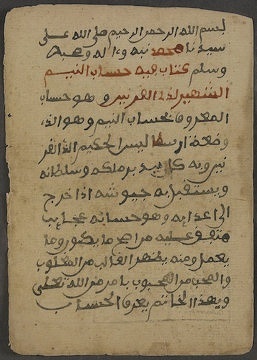
"On the Calculation of Numbers in the Science of Astronomy" from Timbuktu, 1100
Seyyed Hossein Nasr wrote in “Science and Civilization in Islam”: “The various levels of reference existing hierarchically within the structure of Islam are presented concisely by a sage who lived in the fifth/eleventh century, and who is probably the one Oriental figure most familiar to the modern Western public: 'Umar Khayyam, mathematician and poet extraordinary. That he should be regarded in the Western world, on the strength of his famous quatrains as a skeptical hedonist is itself a sign of the profound lack of understanding between the two worlds; for he was in reality a sage and a gnostic of high standing. What appears to be lack of concern or agnosticism in his poetry is merely an accepted form of expression, within which he incorporated both the drastic remedy that the gnostic applies to religious hypocrisy, and also the reestablishment of contact with reality. (Late Greeks, such as Aenesidemus, had had recourse to the same skeptical device, and with similar intentions). [Source: Seyyed Hossein Nasr, “Science and Civilization in Islam,” New American Library. NY 1968 /+]
“In the following passage from a metaphysical treatise, Khayyam divides the seekers after knowledge into four categories: 1) The theologians, who become content with disputation .and "satisfying" proofs, and consider this much knowledge of the Creator (excellent is His Name) as sufflcient. 2) The philosophers and learned men [of Greek inspiration] who use rational arguments and seek to know the laws of logic, and are never content merely with "satisfying" arguments. But they too cannot remain faithful to the conditions of logic, and become helpless with it. 3) The Ismailis [a branch of Shia Islam] and others who say that the way of knowledge is none other than receiving information from a learned and credible informant; for, in reasoning about the knowledge of the Creator, His Essence and Attributes, there is much difficulty; the reasoning power of the opponents and the intelligent [of those who struggle against the final authority of the revelation, and of those who fully accept it] is stupefied and helpless before it. Therefore, they say, it is better to seek knowledge from the words of a sincere person. 4) The Sufis, who do not seek knowledge by meditation or discursive thinking, but by purgation of their inner being and the purifying of their dispositions. They cleanse the rational soul of the impurities of nature and bodily form, until it becomes pure substance. It then comes face to face with the spiritual world, so that the forms of that world become truly reflected in it, without doubt or ambiguity. /+\
“This is the best of all ways, because none of the perfections of God are kept away from it, and there are no obstacles or veils put before it. Therefore, whatever [ignorance] comes to man is due to the impurity of his nature; if the veil be lifted and the screen and obstacle removed, the truth of things as they are will become manifest. And the Master [the Prophet Muhammad] -- upon whom be peace -- indicated this when he said: "Truly, during the days of your existence, inspirations come from God. Do you not want to follow them?"Tell unto reasoners that, for the lovers of God [gnostics] intuition is guide, not discursive thought.” /+\
Medicine under the Abassids
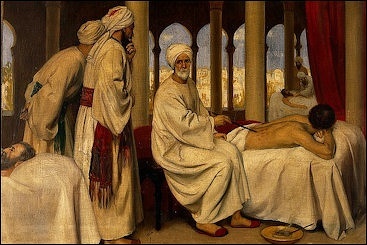
Albucasis blistering a patient in a Cordoba hospital
Gaston Wiet wrote in “Baghdad: Metropolis of the Abbasid Caliphate": “Harun al-Rashid, Mamun's father, was particularly interested in the physicians brought to his capital. The physicians who had become justly famous under the first caliphs of Baghdad had been students at the Persian school of Jundaisapur. The first representative of the famous Bakhtyashu family came from this school, too. The family furnished physicians to the Abbasid court for more than 250 years. The biography of one of them indicates that the examination of urine was a common practice. [Source: Gaston Wiet, “Baghdad: Metropolis of the Abbasid Caliphate,” Chapter 5: the Golden Age the Golden Age of Arab and Islamic Culture translated by Feiler Seymour University of Oklahoma Press, 1971 ]
“The Nestorian Christian, Yahya ibn Masawayh, wrote many works on fevers, hygiene, and dietetics. His was the first treatise on ophthalmology, but he was soon surpassed in this field by his famous pupil, Hunain ibn Ishaq. Their books are of special value since there is no Greek treatise on the subject.
“Particular mention should be made of the man to whom Arab science owes so much, the man who could be called the father of Arab medicine, Hunain ibn Ishaq, also a Christian. In medieval Latin translations he was known as Johannitius. For him the caliph Mutawakkil restored the translation bureau, which had been originally established by Mamun. Not only did Hunain work at translations, but he directed a team of scholars. His enthusiasm was responsible for great progress. He can be credited with having greatly increased the scientific knowledge of the Arabs. By inventing medical and philosophical terms, he was largely instrumental in forming a scientific language. Thanks to him and his collaborators, Arab writers formed the cultural avant-garde for a century or two. In the field of morals, this school was the first to translate the Hippocratic Oath.
“Razi, the physician of genius known in medieval Europe as Rhazes, profited greatly from these works. His own medical work was extensive. This fine clinician, who had universal interests, had his differences with the Moslem religion because he was opposed to all dogmatism. For this reason, extremely violent diatribes were directed against him.
Avicenna On Medicine (1020)
Charles F. Horne wrote: “Avicenna (973-1037) was a sort of universal genius, known first as a physician. To his works on medicine he afterward added religious tracts, poems, works on philosophy, on logic, as physics, on mathematics, and on astronomy. He was also a statesman and a soldier, and he is said to have died of debauchery.” [Source:Charles F. Horne, ed., The Sacred Books and Early Literature of the East, (New York: Parke, Austin, & Lipscomb, 1917), Vol. VI: Medieval Arabia, pp. 90-91.
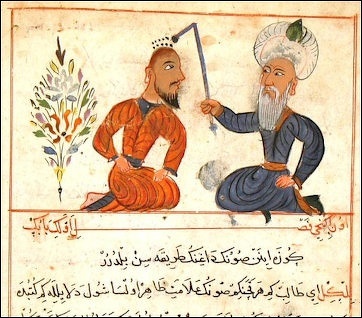
In “On Medicine”, Avicenna wrote: “Medicine considers the human body as to the means by which it is cured and by which it is driven away from health. The knowledge of anything, since all things have causes, is not acquired or complete unless it is known by its causes. Therefore in medicine we ought to know the causes of sickness and health. And because health and sickness and their causes are sometimes manifest, and sometimes hidden and not to be comprehended except by the study of symptoms, we must also study the symptoms of health and disease. Now it is established in the sciences that no knowledge is acquired save through the study of its causes and beginnings, if it has had causes and beginnings; nor completed except by knowledge of its accidents and accompanying essentials. Of these causes there are four kinds: material, efficient, formal, and final.
“Material causes, on which health and sickness depend, are— the affected member, which is the immediate subject, and the humors; and in these are the elements. And these two are subjects that, according to their mixing together, alter. In the composition and alteration of the substance which is thus composed, a certain unity is attained.
“Efficient causes are the causes changing and preserving the conditions of the human body; as airs, and what are united with them; and evacuation and retention; and districts and cities, and habitable places, and what are united with them; and changes in age and diversities in it, and in races and arts and manners, and bodily and animate movings and restings, and sleepings and wakings on account of them; and in things which befall the human body when they touch it, and are either in accordance or at variance with nature.
“Formal causes are physical constitutions, and combinations and virtues which result from them. Final causes are operations. And in the science of operations lies the science of virtues, as we have set forth. These are the subjects of the doctrine of medicine; whence one inquires concerning the disease and curing of the human body. One ought to attain perfection in this research; namely, how health may be preserved and sickness cured. And the causes of this kind are rules in eating and drinking, and the choice of air, and the measure of exercise and rest; and doctoring with medicines and doctoring with the hands. All this with physicians is according to three species: the well, the sick, and the medium of whom we have spoken.
Arab Astronomy
Arab astronomers calculated the circumference of the earth, systematically studied and charted the stars and were aware of the moon's relationship to the tides. Copernicus's theory of planets revolving around the sun had been explored by Arab astronomers two centuries before Copernicus. The Muslim mathematician and astronomer Ibn al-Haytham studied atmospheric refraction around the A.D. 1000. Khorezm-based Al-Beruni was a pioneering astronomer in the 11th century. He worked in Guganj (present-day Konye-Urgench) and figured out the earth rotated and revolved around the sun and estimated the distance to moon correctly within 20 kilometers.
Arab astronomers used astrolabes, quadrants, globes and other tools. They also gave Arabic names to prominent starts such as Regel, Vega, Betelgeuse, Altair and Aldebaran. Of the 57 stars chosen by international agreement for navigation purpose, 38 have Arab names. Arabs also identified groups of stars using the signs of the zodiac like Leo and Sagittarius. Azimuth, zenith, nadir, altitude, almanac are all derided from Arabic words. Great observatories were were built in Baghdad and Samarkand.
Ulughbek, Tamerlane's grandson, ruled a Samarkand-based kingdom much smaller than Tamerlane's empire from 1409 to 1449. He was a humanist, historian, poet, and composer and a pioneer in mathematics and medicine. He built a astronomical observatory and mapped 1,000 stars, 200 of them previously unknown, using a massive 30-meter marble astrolabe, and calculated the length of the year with a high degree of accuracy. In 1420, he founded Samarkand madrassah, regarded as one of the greatest “universities” in the Muslim world.
Marika Sardar wrote of the Metropolitan Museum of Art wrote: “During the medieval period, scientists in the Islamic world made many contributions to the field of astronomy. While their work was based on ancient sources from Greece, Iran, and India, they updated methods for measuring and calculating the movement of heavenly bodies, and continued to develop models of the universe and the movements of the planets within it. Between the eighth and tenth centuries, Baghdad was a major center of study under the Abbasid caliphs al-Mansur (r. 754–75) and al-Macmun (r. 813–33), but local rulers across the region, in Cairo, Rayy, Isfahan, and other cities, also supported scientific research. [Source:Sardar, Marika. "Astronomy and Astrology in the Medieval Islamic World", Metropolitan Museum of Art metmuseum.org \^/]
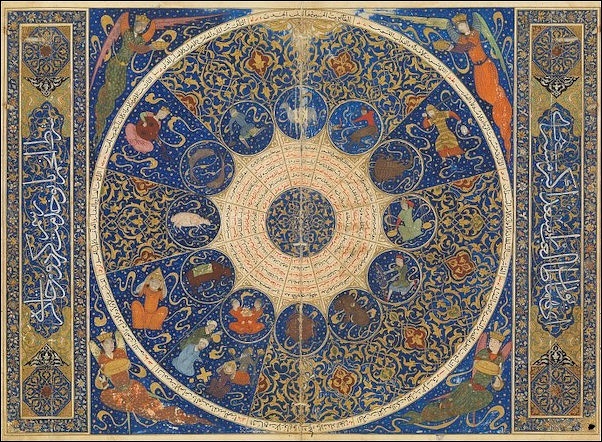
Persian star chart from 1414
“At this time, scientists translated studies in Sanskrit, Pahlavi, and Greek into Arabic, and, for the first time, recorded Arab Bedouin traditions. The Indian Sanskrit and Persian Pahlavi sources taught medieval astronomers methods for calculating the position of heavenly bodies, and for creating tables recording the movement of the sun, the moon, and the five known planets. The Bedouin traditions contained knowledge on the fixed stars, the passage of the sun and moon through the zodiacal signs and lunar mansions, and the seasons and associated phenomenon. This body of knowledge was refined in part because of the specific requirements of Islam; the religion required the ability to correctly determine the time and direction of Mecca for prayer, the moment of sunrise and sunset for fasting during Ramadan, and for fixing the appearance of the moon that marked the start of a new month. This led to the refinement of scientific instruments, an improvement in methods for making observations, and the creation of new calendrical systems.\^/
“Another branch of research was led by astronomers interested in a more accurate understanding of the planets' movements, in response to Greek inquiries into this field. The most influential Greek texts were more concerned with creating a model of the universe and the movement of the heavenly bodies within it, but the literature proposed two very different approaches to this problem. On the one hand, Aristotle's (384–322 B.C.) model of the universe, with the earth at its center, and the sun, moon, planets, and fixed stars rotating around it within uniformly turning spheres, was widely accepted. On the other hand, the work of Ptolemy (85–165 A.D.) sought a purely theoretical, geometrical representation of the universe based on precise observations, even if this conflicted with the ideal Aristotelian model of planets and stars.\^/
Between the ninth and eleventh centuries, Islamic astronomers focused on criticizing and improving the geometrical models of Ptolemy. cAbd al-Rahman al-Sufi (903–986) was one of the most important scientists doing this work, supported by the Buyid sultan cAdud al-Dawla, to whom he dedicated his Illustrated Book of the Fixed Stars (13.160.10). This treatise describes the forty-eight constellations formed by what were called the "fixed stars" (the celestial objects that did not seem to move in relation to the other stars). It was written in Arabic, the language in which most scientists of the Islamic world worked, and was based on a series of new observations made by al-Sufi at Isfahan, the city in central Iran. Other important scientists of the time include al-Biruni (973–1048), who wrote al-Qanun al-Mascudi, dedicated to Sultan Mascud of Ghazna, on the topics of astronomy and solar, lunar, and planetary motions; and Ibn al-Haytham (known in Europe as Alhazen, d. 1039), who measured the thickness of the atmosphere and its effect on astronomical observations.\^/
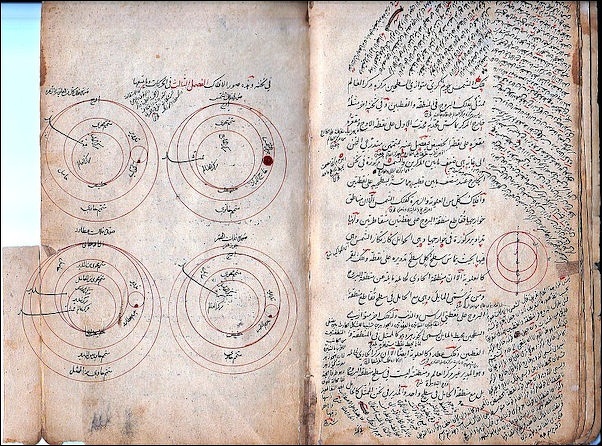
Persian astrological manuscript
Extraordinary Machines of Ismail al-Jazari
Jorge Elices wrote in National Geographic: Fountains that could be programmed to switch on and off. A model of an Indian mahout (driver) who struck the half hour on his elephant’s head. Automatons in the form of servants that could offer guests a towel. These are just some of the marvelous inventions of the 12th-century Muslim inventor Ismail al-Jazari, who laid the groundwork for modern engineering, hydraulics, and even robotics. While some of his lavish and colorful creations were made as novelty playthings for the very wealthy, al-Jazari also made practical machines that helped normal people, including water-drawing devices that were used by farmers for centuries. [Source: Jorge Elices, National Geographic, July 30, 2020]
Most of his innovations were centuries ahead of the achievements of European science. His work on conical valves — a key component in hydraulic engineering — was first mentioned in Europe more than two centuries later by Leonardo da Vinci, who was also reportedly fascinated by al-Jazari’s automatons. Today al-Jazari’s name inspires awe among science historians. Engineer and technology historian Donald R. Hill, author of a landmark 1974 translation of The Book of Knowledge, said the importance of al-Jazari’s work “is impossible to over-emphasize.” As the father of robotics, he has been described as the “Leonardo da Vinci of the East,” a moniker that is in many ways a misnomer. It might be more accurate to describe Leonardo as the “al-Jazari of the West.”
Badi al-Zaman Abu al-Izz Ismail ibn al-Razzaz al-Jazari was born in 1136 in Diyarbakır in what is today central-southern Turkey. The son of a humble craftsman, he was born in a time of political turmoil, a result of local power struggles as well as the effects of the Crusades. [Source: Jorge Elices, National Geographic, July 30, 2020] Al-Jazari served as an engineer in the service of the regional rulers, the Artuqids. This dynasty had once expanded its empire into Syria. In the course of al-Jazari’s lifetime, however, Artuqid power came under the sway of the more powerful neighboring Zangid dynasty, and later still by the successors of the Muslim hero, Saladin. (Here's why the "Assassins" were sent to kill Saladin.)
Despite the upheaval of the Crusades, and the turbulent relations between different Muslim powers, life for the brilliant engineer was peacefully spent serving several Artuqid kings, for whom he designed more than a hundred ingenious devices. Unlike other practical inventors of the period, who left little record of their work, al-Jazari had a passion for documenting his work and explaining how he built his incredible machines. Al-Jazari died in 1206, the year that he presented the sultan with his Book of Knowledge. He is remembered principally for this book, but his realized inventions would play a key role in civic life for many years to come. Among them was a water supply system using gears and hydraulic energy, which was used in the mosques and hospitals of Diyarbakir and Damascus. In some cases, systems modeled on his design remained in use until recent times.
The Book of Knowledge of Ingenious Mechanical Devices

Al Jazari water device from the 13th century
Jorge Elices wrote in National Geographic: In 1206, drawing on a quarter of a century of prodigious output, he gave the world a catalog of his “matchless machines,” which is known today as The Book of Knowledge of Ingenious Mechanical Devices. Al-Jazari included meticulous diagrams and colorful illustrations to show how all the pieces fit together. Several incomplete copies of his work have survived, including one held by the Topkapi Sarayi Museum in Istanbul, Turkey, prized for its artistic detail and beauty. [Source: Jorge Elices, National Geographic, July 30, 2020]
The Book of Knowledge is the only source of biographical information that exists on al-Jazari. The text exalts him as Badi al-Zaman (unique and unrivaled) and al-Shaykh (learned and worthy), but it also acknowledges the debt he owed to “ancient scholars and wise men.” Al-Jazari’s inventions benefited from centuries of innovation and scholarship from previous eras, drawing on science and wisdom from ancient Greek, Indian, Persian, Chinese and other cultures. During the rapid expansion of Islam in the seventh century, Muslim rulers took a deep interest in the knowledge of the lands they conquered. They collected manuscripts and books at the Bayt al-Hikma (House of Wisdom). This institution thrived under the Abbasid caliphs of Baghdad in the eighth and ninth centuries as a library and academy. Along with other centers, it played a fundamental role in the medieval scientific and scholarly advances during the golden age of Islam. (Discover how early Islamic science advanced medicine.)
Along with philosophy, medicine, astronomy, and zoology, Muslim mechanical engineering reached exceptional heights at the hands of outstanding figures, including a trio of ninth-century Persian inventors, the Banu Musa brothers. They published many works, but al-Jazari was most likely influenced by their inventions featured in The Book of Ingenious Devices (also known as The Book of Tricks). Al-Jazari was also influenced by non-Muslim inventors such as the late third-century B.C. Apollonius of Perga, an influential geometrist whom al-Jazari credits in his work.
Al-Jazari’s intention was not only to build on the legacy of these great inventors but to perfect it. He wrote in his foreword to The Book of Knowledge: “I found that some of the earlier scholars and sages had made devices and had described what they had made. They had not considered them completely nor had they followed the correct path for all of them... and so wavered between the true and the false.”
The humble nature of The Book of Knowledge is also reflected in its language. While other inventors deliberately couched their prose in obscure language to limit it to a small elite, al-Jazari took pains to make it accessible to a general reader of the time so that they might build some of his more practical machines. Given that al-Jazari was as much interested in construction processes as in theory and calculations, some researchers have even described his book as a kind of “user’s manual.”
“First Robot” and Other Ismail al-Jazari’s Machines
Jorge Elices wrote in National Geographic: The machines in al-Jazari’s book were both practical and playful, from clocks to automaton vessels dispensing drinks. He designed bloodletting devices, fountains, musical automatons; water-raising machines; and machines for measuring. A miniature from al-Jazari’s Book of Knowledge depicts a water-powered flautist automation that he described as a playful “alarm clock,” designed to deliver a gentle tone to wake someone from a nap. Topkapi Sarayi Museum, Istanbul. [Source: Jorge Elices, National Geographic, July 30, 2020]
One of the most famous of his devices is an enormous water clock that featured an elephant carrying his driver and a tower filled with creatures. Simple water clocks had been used in ancient Egypt and Babylonia, but al-Jazari’s intricate invention clearly expresses his ambition to perfect them. The different creatures that animate every half hour represent different cultures, like the dragons from China and the elephant of India. Every half hour, the internal mechanisms activate: The bird atop the dome whistles, a man drops a ball into a dragon’s mouth, and the elephant driver strikes the beast’s head.
A handsome boat from which can be told the passage of an hour: In the boat is a man . . .in his right hand is a pipe, its end in his mouth . . . The boat fills and submerges in the space of one constant hour [and] the sailor plays the pipe . . . I made this device so that [a sleeper] will know from the pipe that the boat has sunk, and will wake from his doze at the sound.
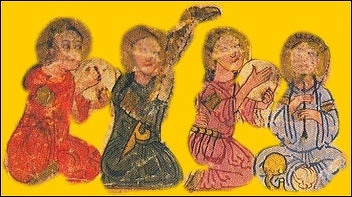
Al-Jazari robots from the 13th century
Another of al-Jazari’s fantastical contraptions is of special interest to historians of science as it is regarded by many to be the first programmable “robot” in history. Much like a music box, this invention, a boat with four “musicians” — a harpist, a flautist, and two drummers — was designed to play songs to entertain. The mechanisms animating the drummers could be programmed to play different beats. (Robots entertained in al-Jazari's time, but their new abilities will transform ours.) [Source: Jorge Elices, National Geographic, July 30, 2020]
For all their ingenuity, such devices were playthings for the rich. With his courtier hat on, al-Jazari understood the need to dazzle his rich patrons, who would, in turn, dazzle visiting dignitaries with their resident genius’s latest wonder. As a craftsman from a modest background, he also knew the needs of the everyday and devised useful gadgets that would lighten the burden of everyday toil. The book describes in detail at least five machines that facilitated drawing water and irrigating, on the farm and at home. Other highly practical machines were also included in his book: a crank shaft that converts linear movement into rotary movement; and a means for the exact calibration of locks and other apertures, among much else.
Image Sources: Wikimedia, Commons
Text Sources: Internet Islamic History Sourcebook: sourcebooks.fordham.edu “World Religions” edited by Geoffrey Parrinder (Facts on File Publications, New York); “ Arab News, Jeddah; “Islam, a Short History” by Karen Armstrong; “A History of the Arab Peoples” by Albert Hourani (Faber and Faber, 1991); “Encyclopedia of the World Cultures” edited by David Levinson (G.K. Hall & Company, New York, 1994). “ Encyclopedia of the World’s Religions” edited by R.C. Zaehner (Barnes & Noble Books, 1959); Metropolitan Museum of Art, National Geographic, BBC, New York Times, Washington Post, Los Angeles Times, Smithsonian magazine, The Guardian, BBC, Al Jazeera, Times of London, The New Yorker, Time, Newsweek, Reuters, Associated Press, AFP, Lonely Planet Guides, Library of Congress, Compton’s Encyclopedia and various books and other publications.
Last updated March 2024
